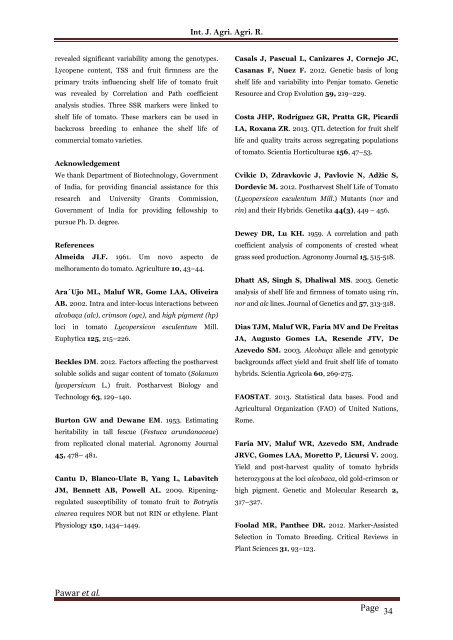Phenotypic evaluation and molecular characterization of alc/vaibhav recombinant inbred population of tomato for yield, shelf life and fruit quality parameters
Tomato is second most important vegetable, having nutritional and aesthetic value. Due to high temperature and lack of proper storage facility most of the produce is wasted. This loss can be reduced by increasing shelf life of tomato, so that produce can be stored for long time. In the present investigation alcobacca, a ripening mutant of tomato has been crossed with tomato variety, Vaibhav. To dissect trait genetics, Genetic variability, Correlation and path coefficient analysis were conducted in the F6 recombinant inbred population developed from alc x Vaibhav by single seed descent method. Highest shelf life of 85 days was observed with a mean of 51 days for RILs. Shelf life was significantly and positively associated with fruits per cluster (0.13@5%), fruit firmness (0.23 @ 1%, 5%), total soluble solutes (0.15@1%,5%), lycopene content (0.12@5%), yield per plant (0.30@1%,5%) and number of fruits per plant (0.38@1%,5%). Thirty eight polymorphic SSR markers have been screened for RILs. QTL detection was done using ANOVA and Linear regression using Minitab® 16.1.1. Three SSR markers viz., SSR146, LEaat007 and TGS2259 have been found to be linked to shelf life with R square value of 2.9, 4.1 and 3.5 respectively.
Tomato is second most important vegetable, having nutritional and aesthetic value. Due to high temperature and lack of proper storage facility most of the produce is wasted. This loss can be reduced by increasing shelf life of tomato, so that produce can be stored for long time. In the present investigation alcobacca, a ripening mutant of tomato has been crossed with tomato variety, Vaibhav. To dissect trait genetics, Genetic variability, Correlation and path coefficient analysis were conducted in the F6 recombinant inbred population developed from alc x Vaibhav by single seed descent method. Highest shelf life of 85 days was observed with a mean of 51 days for RILs. Shelf life was significantly and positively associated with fruits per cluster (0.13@5%), fruit firmness (0.23 @ 1%, 5%), total soluble solutes (0.15@1%,5%), lycopene content (0.12@5%), yield per plant (0.30@1%,5%) and number of fruits per plant (0.38@1%,5%). Thirty eight polymorphic SSR markers have been screened for RILs. QTL detection was done using ANOVA and Linear regression using Minitab® 16.1.1. Three SSR markers viz., SSR146, LEaat007 and TGS2259 have been found to be linked to shelf life with R square value of 2.9, 4.1 and 3.5 respectively.
Create successful ePaper yourself
Turn your PDF publications into a flip-book with our unique Google optimized e-Paper software.
Int. J. Agri. Agri. R.<br />
revealed significant variability among the genotypes.<br />
Lycopene content, TSS <strong>and</strong> <strong>fruit</strong> firmness are the<br />
primary traits influencing <strong>shelf</strong> <strong>life</strong> <strong>of</strong> <strong>tomato</strong> <strong>fruit</strong><br />
was revealed by Correlation <strong>and</strong> Path coefficient<br />
analysis studies. Three SSR markers were linked to<br />
<strong>shelf</strong> <strong>life</strong> <strong>of</strong> <strong>tomato</strong>. These markers can be used in<br />
backcross breeding to enhance the <strong>shelf</strong> <strong>life</strong> <strong>of</strong><br />
commercial <strong>tomato</strong> varieties.<br />
Acknowledgement<br />
We thank Department <strong>of</strong> Biotechnology, Government<br />
<strong>of</strong> India, <strong>for</strong> providing financial assistance <strong>for</strong> this<br />
research <strong>and</strong> University Grants Commission,<br />
Government <strong>of</strong> India <strong>for</strong> providing fellowship to<br />
pursue Ph. D. degree.<br />
References<br />
Almeida JLF. 1961. Um novo aspecto de<br />
melhoramento do <strong>tomato</strong>. Agriculture 10, 43–44.<br />
Ara´Ujo ML, Maluf WR, Gome LAA, Oliveira<br />
AB. 2002. Intra <strong>and</strong> inter-locus interactions between<br />
<strong>alc</strong>obaça (<strong>alc</strong>), crimson (ogc), <strong>and</strong> high pigment (hp)<br />
loci in <strong>tomato</strong> Lycopersicon esculentum Mill.<br />
Euphytica 125, 215–226.<br />
Beckles DM. 2012. Factors affecting the postharvest<br />
soluble solids <strong>and</strong> sugar content <strong>of</strong> <strong>tomato</strong> (Solanum<br />
lycopersicum L.) <strong>fruit</strong>. Postharvest Biology <strong>and</strong><br />
Technology 63, 129–140.<br />
Burton GW <strong>and</strong> Dewane EM. 1953. Estimating<br />
heritability in tall fescue (Festuca arundanaceae)<br />
from replicated clonal material. Agronomy Journal<br />
45, 478– 481.<br />
Cantu D, Blanco-Ulate B, Yang L, Labavitch<br />
JM, Bennett AB, Powell AL. 2009. Ripeningregulated<br />
susceptibility <strong>of</strong> <strong>tomato</strong> <strong>fruit</strong> to Botrytis<br />
cinerea requires NOR but not RIN or ethylene. Plant<br />
Physiology 150, 1434–1449.<br />
Casals J, Pascual L, Canizares J, Cornejo JC,<br />
Casanas F, Nuez F. 2012. Genetic basis <strong>of</strong> long<br />
<strong>shelf</strong> <strong>life</strong> <strong>and</strong> variability into Penjar <strong>tomato</strong>. Genetic<br />
Resource <strong>and</strong> Crop Evolution 59, 219–229.<br />
Costa JHP, Rodríguez GR, Pratta GR, Picardi<br />
LA, Roxana ZR. 2013. QTL detection <strong>for</strong> <strong>fruit</strong> <strong>shelf</strong><br />
<strong>life</strong> <strong>and</strong> <strong>quality</strong> traits across segregating <strong>population</strong>s<br />
<strong>of</strong> <strong>tomato</strong>. Scientia Horticulturae 156, 47–53.<br />
Cvikic D, Zdravkovic J, Pavlovic N, Adžic S,<br />
Dordevic M. 2012. Postharvest Shelf Life <strong>of</strong> Tomato<br />
(Lycopersicon esculentum Mill.) Mutants (nor <strong>and</strong><br />
rin) <strong>and</strong> their Hybrids. Genetika 44(3), 449 – 456.<br />
Dewey DR, Lu KH. 1959. A correlation <strong>and</strong> path<br />
coefficient analysis <strong>of</strong> components <strong>of</strong> crested wheat<br />
grass seed production. Agronomy Journal 15, 515-518.<br />
Dhatt AS, Singh S, Dhaliwal MS. 2003. Genetic<br />
analysis <strong>of</strong> <strong>shelf</strong> <strong>life</strong> <strong>and</strong> firmness <strong>of</strong> <strong>tomato</strong> using rin,<br />
nor <strong>and</strong> <strong>alc</strong> lines. Journal <strong>of</strong> Genetics <strong>and</strong> 57, 313-318.<br />
Dias TJM, Maluf WR, Faria MV <strong>and</strong> De Freitas<br />
JA, Augusto Gomes LA, Resende JTV, De<br />
Azevedo SM. 2003. Alcobaça allele <strong>and</strong> genotypic<br />
backgrounds affect <strong>yield</strong> <strong>and</strong> <strong>fruit</strong> <strong>shelf</strong> <strong>life</strong> <strong>of</strong> <strong>tomato</strong><br />
hybrids. Scientia Agricola 60, 269-275.<br />
FAOSTAT. 2013. Statistical data bases. Food <strong>and</strong><br />
Agricultural Organization (FAO) <strong>of</strong> United Nations,<br />
Rome.<br />
Faria MV, Maluf WR, Azevedo SM, Andrade<br />
JRVC, Gomes LAA, Moretto P, Licursi V. 2003.<br />
Yield <strong>and</strong> post-harvest <strong>quality</strong> <strong>of</strong> <strong>tomato</strong> hybrids<br />
heterozygous at the loci <strong>alc</strong>obaca, old gold-crimson or<br />
high pigment. Genetic <strong>and</strong> Molecular Research 2,<br />
317–327.<br />
Foolad MR, Panthee DR. 2012. Marker-Assisted<br />
Selection in Tomato Breeding. Critical Reviews in<br />
Plant Sciences 31, 93–123.<br />
Pawar et al.<br />
Page 34


















